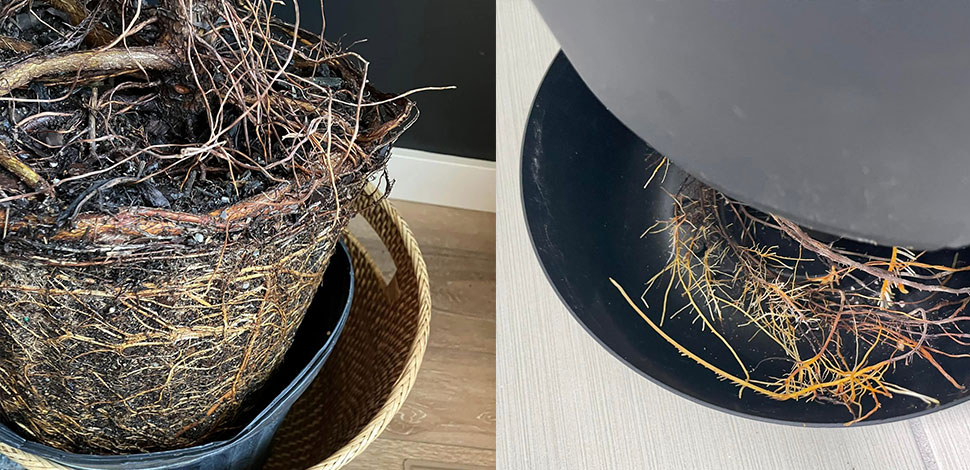Why Repot a Fiddle Leaf Fig Tree?
Repotting is an essential task for any plant, especially for Fiddle Leaf Fig trees. Over time, the soil in which the tree is potted can become compacted, hindering proper drainage and nutrient absorption. Repotting your Fiddle Leaf Fig tree will not only ensure it has enough space to grow, but also provide fresh, nutrient-rich soil that will help it thrive.
When to Repot Fiddle Leaf Fig Tree?
It’s important to repot your Fiddle Leaf Fig tree when it outgrows its current pot. Signs that your tree needs repotting include roots growing out of the drainage holes or visible on the surface of the soil, yellowing leaves, and stunted growth. Spring and summer are the best seasons to repot your tree, as it’s the time when the plant is actively growing.

Steps to Repot Your Fiddle Leaf Fig Tree:
- Water your Fiddle Leaf Fig a few days before repotting to help it recover from the shock of being moved.
- Choose the Right Pot: Pick a pot that is one or two inches larger than the current pot. Make sure the new pot has good drainage holes at the bottom.It is crucial to have a good understanding of proper drainage to ensure the long-term health of your fiddle leaf fig plant. These plants are prone to root rot, making it essential to ensure that your container has ideal drainage and your plant is never left sitting in water. To achieve this, it is recommended to use a container with a drainage hole, coupled with cactus mix or Smart Gravel to keep your root ball dry.
- Prepare the Soil: Use high-quality, well-draining soil that is rich in nutrients. You can mix in perlite or sand to improve drainage.
- Gently Remove the Tree: Carefully lift the tree out of its current pot, and gently loosen any tangled roots.
- Add Soil to the New Pot: Fill the new pot with soil, leaving enough room for the root ball.
- Repot Your Tree: Place the tree in the new pot, and fill in any gaps with soil. Make sure the tree is upright and at the same depth as before.
- Water Your Tree: Give your Fiddle Leaf Fig tree a thorough watering, and let any excess water drain out of the bottom.

Aftercare Tips
After repotting, it’s important to take proper care of your Fiddle Leaf Fig to help it recover from the shock of being transplanted. Here are some aftercare tips:
- Do not fertilize for at least a month after repotting to avoid burning the roots.
- Keep your Fiddle Leaf Fig in a bright, indirect light location and away from drafts.
- Fertilize your tree every month during the growing season.
- Monitor your tree for signs of pests or disease.
Common Mistakes to Avoid
When repotting a Fiddle Leaf Fig, there are a few common mistakes to avoid:
- Using too large of a pot
- Using soil that doesn’t drain well
- Not watering enough or watering too much
- Not giving your Fiddle Leaf Fig enough light
Avoiding these mistakes will help ensure the success of your Fiddle Leaf Fig’s repotting process.
Benefits of Repotting Fiddle Leaf Fig
Repotting has many benefits for your Fiddle Leaf Fig, including:
- Increased growth and vitality
- Improved root health
- Better nutrient uptake
- Increased resistance to pests and diseases
By repotting your Fiddle Leaf Fig, you can ensure that it continues to thrive and remain healthy for years to come
FAQs
1. How often should I repot my Fiddle Leaf Fig?
You should repot your Fiddle Leaf Fig every 1-2 years or when the roots outgrow the current pot.
2. What type of soil is best for Fiddle Leaf Figs?
Fiddle Leaf Figs prefer well-draining soil that retains moisture. You can create the perfect soil mix by combining 60% high-quality potting soil, 20% perlite, and 20% peat moss.
3. Can I use a pot without drainage holes?
No, Fiddle Leaf Figs require a pot with drainage holes to prevent water buildup, which can lead to root rot.
4. Should I fertilize my Fiddle Leaf Fig after repotting?
No, you should wait at least a month after repotting before fertilizing to avoid burning the roots.
5. How can I tell if my Fiddle Leaf Fig needs to be repotted?
Signs that your Fiddle Leaf Fig needs to be repotted include roots growing through the drainage holes, slow growth or stunted growth, yellowing or wilting leaves, soil drying out quickly, and lack of drainage.







0 Comments